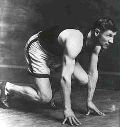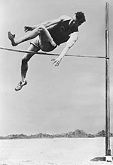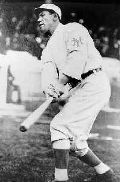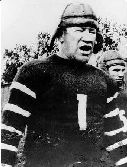|
|
|
 |
|
Jim ThorpeThe Uber-athlete | |
|
Jim Thorpe was the greatest athlete of the 20th Century; some say the
greatest athlete ever. He was excellent at every sport he tried, and the
only American athlete to excel at the amateur and professional levels in
3 major sports - track and field, football and baseball. |
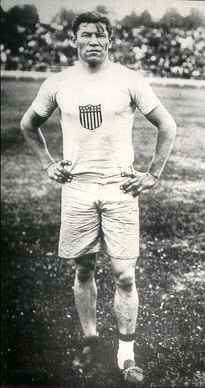 |
Jim's father sent him to Carlisle Indian School near Harrisburg, Pennsylvania, and enrolled him in an apprentice program to become a tailor. Not long after his arrival, he was walking across the sports field and saw some students practicing the high jump. He asked if he could give it a try and easily made the jump, not realizing that the bar was set higher than anyone at the school had ever jumped before. When legendary coach Glenn Scobey "Pop" Warner heard about it, he convinced Jim to join the track and field team.
Jim was an outstanding competitor in track and field, winning many of
the meets the school participated in - practically single-handedly. He
excelled at many other sports; including basketball, lacrosse, baseball,
swimming, ice hockey, archery, boxing, tennis and even won a national
ballroom dancing contest. He was also an outstanding football player and
helped Carlisle win a national championship in 1911. It was a great
accomplishment for such a small school and Coach Warner would later
describe Thorpe as "The most complete athlete in the world."
Jim returned to the US with $50,000 worth of trophies and was greeted with a ticker-tape parade in New York City. He recalled, "I heard people yelling my name and I couldn't realize how one fellow could have so many friends." Thorpe received many offers to join professional sports teams, but Pop Warner convinced him to return to the Carlisle football team. During the 1912 season, Jim scored a total of 198 points, including 25 touchdowns and helped them win the championship once again. A year after the Olympics, a reporter discovered that he had played two seasons of semi-professional baseball in North Carolina. Though he had been paid less than $30 a week, the Amateur Athletic Union voided his amateur status and the Olympic Committee stripped him of his medals. They also removed his name from the record books. The silver medal winners refused to accept his gold medals, and one of them said, "Those belong to Jim."
Jim played baseball during the summer and football during the winter. He was paid $250 a game to play for the Canton Bulldogs - an enormous salary for a football player in those days. He led the team to the championship in 1916, 1917, and 1919. Thorpe was the first great professional football player and helped to make football a popular sport. He was named the first president of the American Professional Football Association, which later became the National Football League. Jim Thorpe was also inducted as a charter member into the Professional Football hall of Fame in 1963, and his statue is located at the entrance to the museum in Canton, Ohio. He played his last football game at the age of 41, and as he got older, he began to drink heavily. He was hired as the superintendent of recreation for the Chicago Park System, but he lost that job because of his drinking. After that, he drifted about and did construction work or odd jobs.
In 1941, at the age of 52, Jim showed the crowd during half time at a football game that he was still an amazing athlete, despite his advancing age. He stood on the 50 yard line and in street shoes, drop-kicked a ball over one goalpost and then turned around and place-kicked another ball over the other goalpost. In 1942, Thorpe tried to enlist in the Army but was rejected, so he served throughout the war as a seaman in the Merchant Marine. In 1950, Thorpe was selected by America's sportswriters as the most outstanding athlete of the first half of the 20th Century. Jim had sold his life story for $3,000 in the 1930s, and it was made into a film in 1951, when Burt Lancaster portrayed him in Jim Thorpe - All American. Later that year, Jim checked into the hospital to undergo surgery for cancer of the lip and it was discovered that he couldn't pay his bill. His wife said, "We're broke. Jim has nothing but his name and his memories. He has spent money on his own people and has given it away. He has often been exploited." Word quickly spread that Thorpe had fallen upon hard times and several thousand dollars was raised by his fans to help him.
For nearly 60 years, Thorpe's fans tried to get his medals and records restored to him. One of the people who had competed against him in the 1912 Olympics was Avery Brundage, who became the head of the United States Olympic Committee and later the head of the International Olympic Committee. Brundage always blocked any effort to reinstate Thorpe, and it wasn't till 1982, after Brundage had died, that Thorpe's medals were finally returned to his family and his records restored. In May 1999, a resolution was introduced in the United States House of Representatives to name Jim Thorpe, "America's Athlete of the Century." |
|

